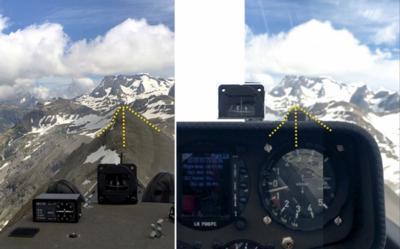Thu, Dec 09, 2021
Pilot Hyperfocused on Filming Mountain, Brought Wing Into Contact With Ridge Face
A Swiss SUST report has been released in regards to a 2016 glider crash wherein a DG-800S glider crashed against the Mittaghore Mountains while on a leisure flight. The report cites the pilot's preoccupation with manipulating his cellular phone to film while flying, resulting in an inadvertent collision between the aircraft's right wing and a nearby mountain ridge.

The Glider was towed into flight from Saanen Airfield on July 6, 2016, where the pilot released the cable to fly along the ridge of Sanetschsee and its pass. Passing through the Arpelistock, the pilot turned towards the nearby mountains with the hopes of approaching the large, imposing summit of Mittaghore for some footage. The glider flew along a ridge, coming within 70 m of the horizontal peak and 110 meters above ground level.
The aircraft passed through a variation of terrain, ultimately maneuvering such a prominently rising portion of Mittaghore was obscured by the instrument panel while filming the interior of the aircraft. The camera was positioned to emphasize the scenic view out the right side, then passed over the pilot's head to capture the widest summit photo possible. The camera panned towards a further mountain as the formerly obscured terrain collided with the right wing of the glider. The aircraft rolled clockwise around its longitudinal and vertial axes. It inverted and impacted the eastern side of Mittaghore and slid downhill for 140 meters, killing the pilot in the process.

The accident occurred on an otherwise fine day for flying, providing another strong warning for the new crop of younger aviators accustomed to filming their activities at all times. Regulations aside, there have been a number of horror stories in most clubs about what can go wrong when flying the plane takes a back seat to getting the perfect shot. From small action cameras broken parts blocking the throttles, to inattentive student pilots rolling inverted while reviewing their camera roll, luck can only cover for so much airborne safety before giving out. For clubs or owners, it may be a helpful risk assessment guide to set standards of minimum filming requirements while in the air, whether they necessitate attachments for hands-off 'set it and forget it' operation, or a second crewmember to handle the in-flight electronics. The report in its entirety can be read in its native German at the Swiss Confederation's SUST website.
More News
Aero Linx: American Aviation Historical Society AAHS is dedicated to the preservation and dissemination of the rich heritage of American aviation. Our purpose is to collect, preser>[...]
CrewMember (UAS) A person assigned to perform an operational duty. A UAS crewmember includes the remote pilot in command, the person manipulating the controls, and visual observers>[...]
Immediately After The Right Main Tire Contacted The Runway Surface, The Right Main Landing Gear Failed On October 31, 2025, at about 1227 Pacific daylight time, a Maule M-7-235A, N>[...]
Also: IAE Acquires Diamond Trainers, Army Drones, FedEx Pilots Warning, DA62 MPP To Dresden Tech Uni The danger to the flight training industry and our future pilots is clear. Dona>[...]
"On December 3, 2025, at approximately 10:45 a.m., a Thunderbird pilot ejected safely from a F-16C Fighting Falcon aircraft during a training mission over controlled airspace in Ca>[...]
 ANN's Daily Aero-Linx (12.03.25)
ANN's Daily Aero-Linx (12.03.25) ANN's Daily Aero-Term (12.03.25): CrewMember (UAS)
ANN's Daily Aero-Term (12.03.25): CrewMember (UAS) NTSB Prelim: Maule M-7-235A
NTSB Prelim: Maule M-7-235A Airborne-Flight Training 12.04.25: Ldg Fee Danger, Av Mental Health, PC-7 MKX
Airborne-Flight Training 12.04.25: Ldg Fee Danger, Av Mental Health, PC-7 MKX Aero-News: Quote of the Day (12.04.25)
Aero-News: Quote of the Day (12.04.25)




